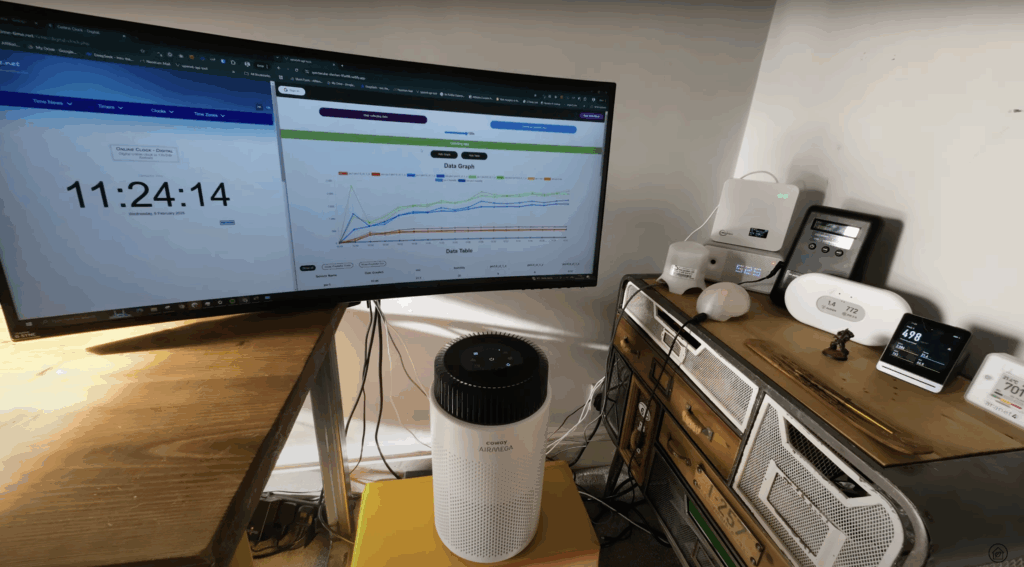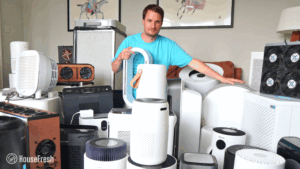Whether you struggle with dust allergies or you’re trying to reduce the amount of dust flying around your home, an air purifier can help.
The fans in air purifiers draw air that then passes through a series of filters, where pollutants are removed. In the case of dust, you need to choose a device with a good particle filter and shouldn’t worry about carbon filtration.
However, not all air purifiers are created equal and some devices won’t pack the power to circulate the air fast enough so it stays clean. That is why, I recommend you to look for an air purifier that will be able to provide at least five air changes per hour, based on how much clean air it can deliver.
And as dust is an ongoing issue in most houses, I suggest to focus on finding an air purifier that runs quietly at top fan speeds and that offers good particle removal performance even at its lowest fan speeds. That way you will be able to run your purifier 24/7 without disruptive noise in the background.
I kept all those points in mind when shortlisting the models I’ll share with you today. As always, all my recommendations are based on first-hand testing of over 100 air purifiers, which we have bought with our own money to remain unbiased and experience the customer journey as you would.
As no two homes are the same, I made sure to include options for various budgets, room sizes and different features.
1. Best dust filtration at whisper-quiet operation: CleanAirKits Luggable XL-7
An air purifier that uses seven Cooler Master SickleFlow 120 PC fans and 20×25 3M MERV 13 MPR1900 filters to quickly remove dust particles from the air without loud noises.

The Luggable XL-7 is part of a new generation of air purifiers that combine PC fans with HVAC filters. This is a device you can build yourself ($189) or buy pre-assembled ($259), and that is powerful enough to clean the air five times per hour in rooms up to 484.5 sq. ft.
The Luggable XL-7 is the quietest high-CADR air purifier we have ever tested thanks to the use of PC fans that are quiet and energy-efficient.

It uses any 20×25×1 filters, but we recommend 3M Filtrete MPR1900.

CONS
PROS
| Clean air delivery rate (CADR): | – Top speed PM1 CADR: 260 cfm – Sub-45 dBA PM1 CADR: 260 cfm – Intertek PM2.5: 323 cfm (dust) |
| Filter technology: | MERV 13 (20×25) |
| Recommended room size: | 390 sq. ft. (5 air changes per hour) |
| Dimensions: | 7D x 25W x 20H in (18D x 64W x 51 cm) |
| Weight: | 8 lbs (3.63 kg) |
| Noise level in decibels from 3 ft. away: | Only speed: 38.8 dBA |
| Electricity consumption in watts: | Only speed: 10.5 watts |
| Filter lifespan: | 6-12 months |
| Manufacturer’s warranty: | 1 year |
| Country of origin: | United States |
| Country of manufacture: | United States |
- If you live in Canada, check out Northbox Systems 6XL. Northbox Systems is a Canadian company that produces PC fan-powered air purifiers that use HVAC filters locally.
- For those in Europe and Asia, check out the AirFanta 3Pro, which costs just $159.99 but still offers 353 cfm at quiet operation. The design is inspired by the Corsi-Rosenthal Box but it is much smaller, and unlike the Luggable XL-7, it uses filters you can buy on Amazon.
2. Best under $200: Levoit Vital 200S
For those looking for a traditional air purifier that will remove dust without costing an arm and a leg to buy and run.
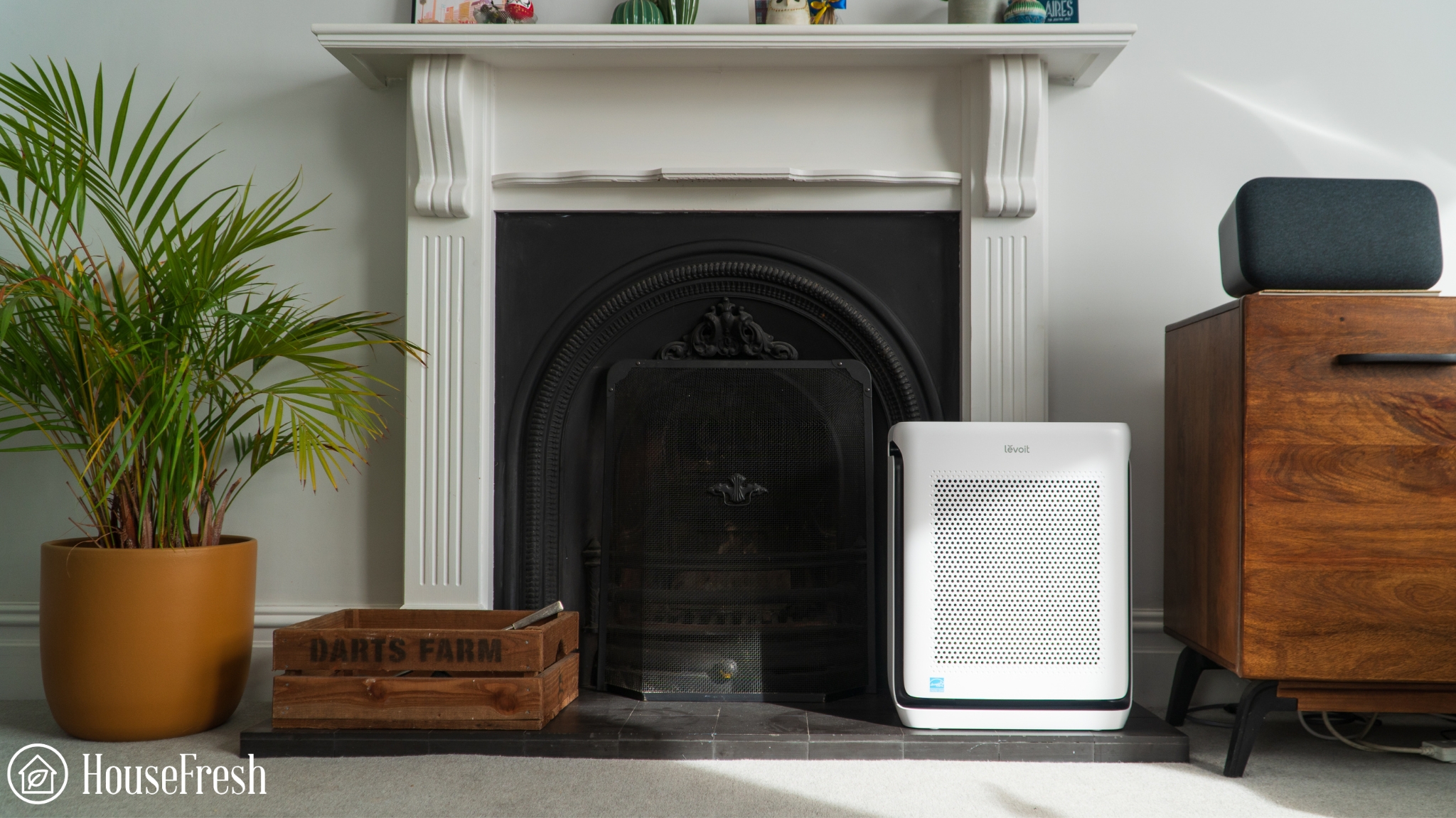
This is a solid air purifier you can buy for $189.99, although it usually goes on sale for less than that. Even though its filter is not HEPA-grade, the particle filtration of the Vital 200S is better than more expensive models.
At top speed (57.7 dBA), it offers a dust CADR of 254 cfm (AHAM), so it can provide five air changes per hour in rooms as large as 381 sq. ft.
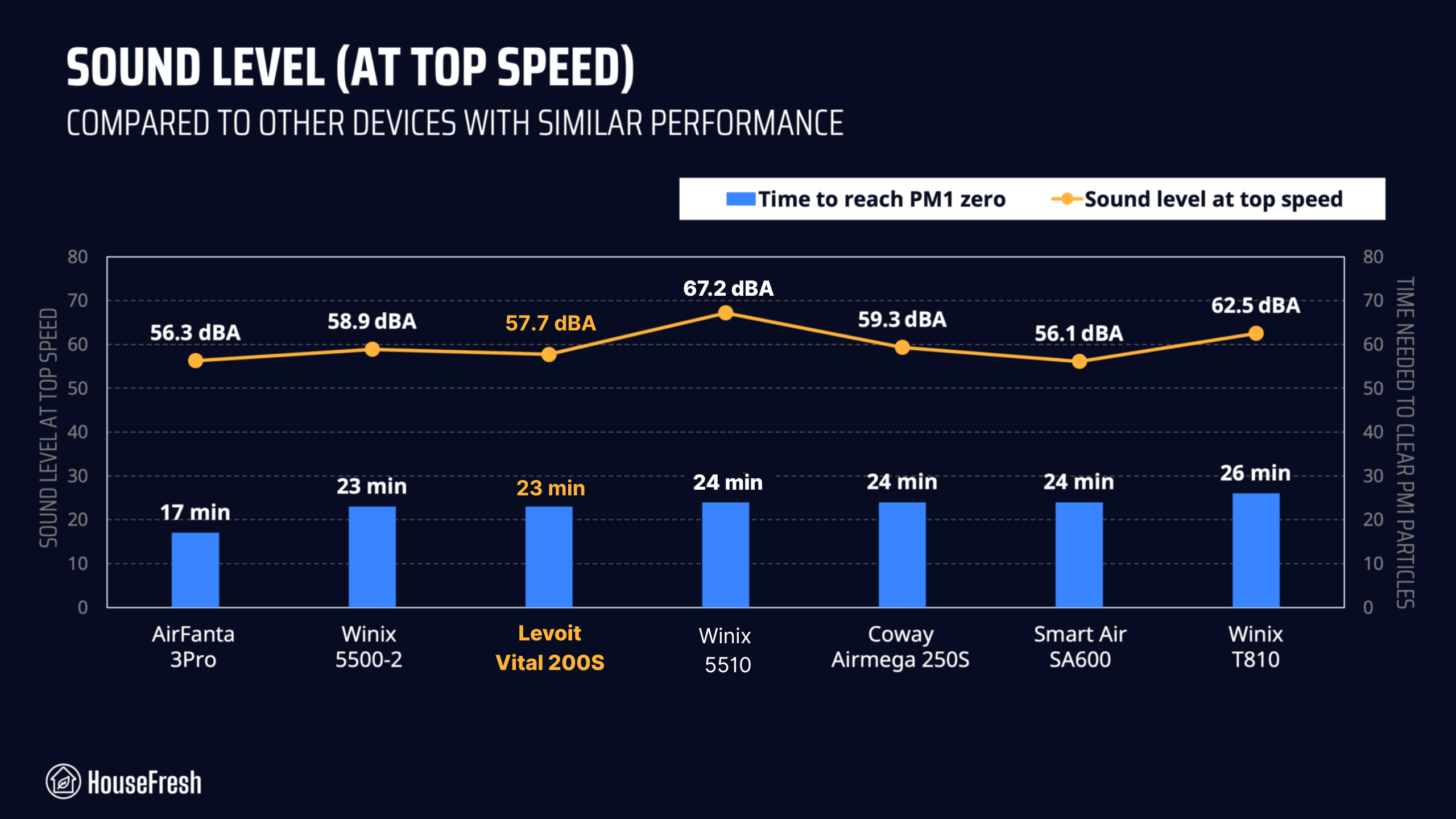
It has an app, an onboard air quality sensor and smart functions that automatically adjust fan speeds based on the level of dust in the air.
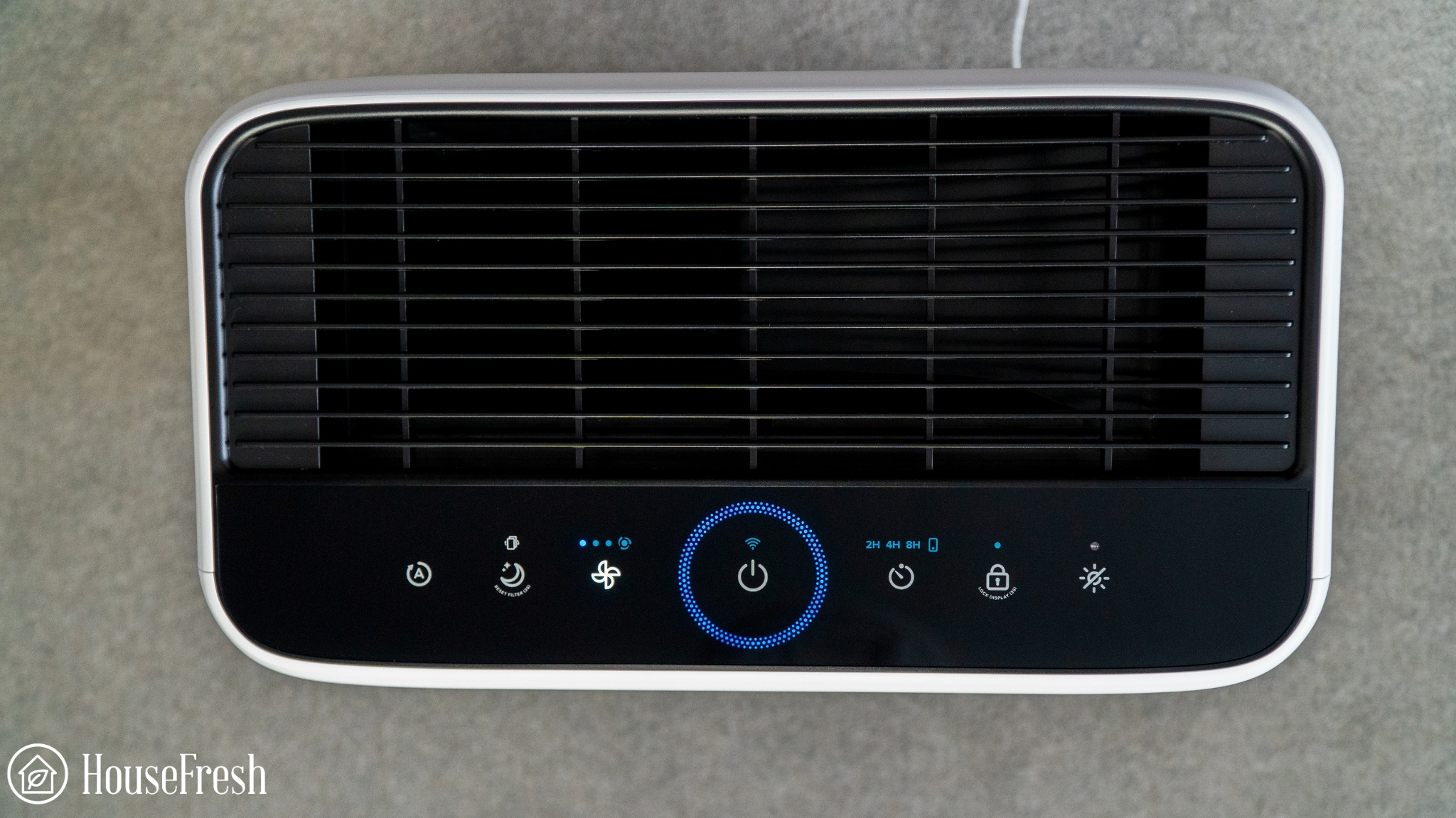
CONS
PROS
| Clean air delivery rate (CADR): | – Top speed PM1 CADR: 260 cfm – Sub-45 dBA PM1 CADR: 128 cfm – AHAM PM2.5 CADR: 254 cfm (dust) |
| Filter technology: | Bonded particle filter with a layer of pelleted activated carbon and a removable pre-filter |
| Recommended room size: | 390 sq. ft. (5 air changes per hour) |
| Dimensions: | 15.6D x 8.5W x 19.8H inches (39.3D x 21.5W x 50.2H cm) |
| Weight: | 13.2 lbs (5.9 kg) |
| Noise level in decibels from 3 ft. away: | Speed 1: 38.3 dB Speed 2: 41.9 dB Speed 3: 53.8 dB Speed 4: 57.7 dB |
| Electricity consumption in watts: | Standby mode: 0.97 watts Speed 1: 5.71 watts Speed 2: 8.01 watts Speed 3: 31.96 watts Speed 4: 44.55 watts |
| Filter lifespan: | 12 months |
| Manufacturer’s warranty: | 2 years |
| Country of origin: | United States |
| Country of manufacture: | China |
3. Best for small spaces: Xiaomi 4 Compact
To deal with dust, you should buy the larger air purifier you can live with. But if you don’t have much space, then the 4 Compact is the best option right now.
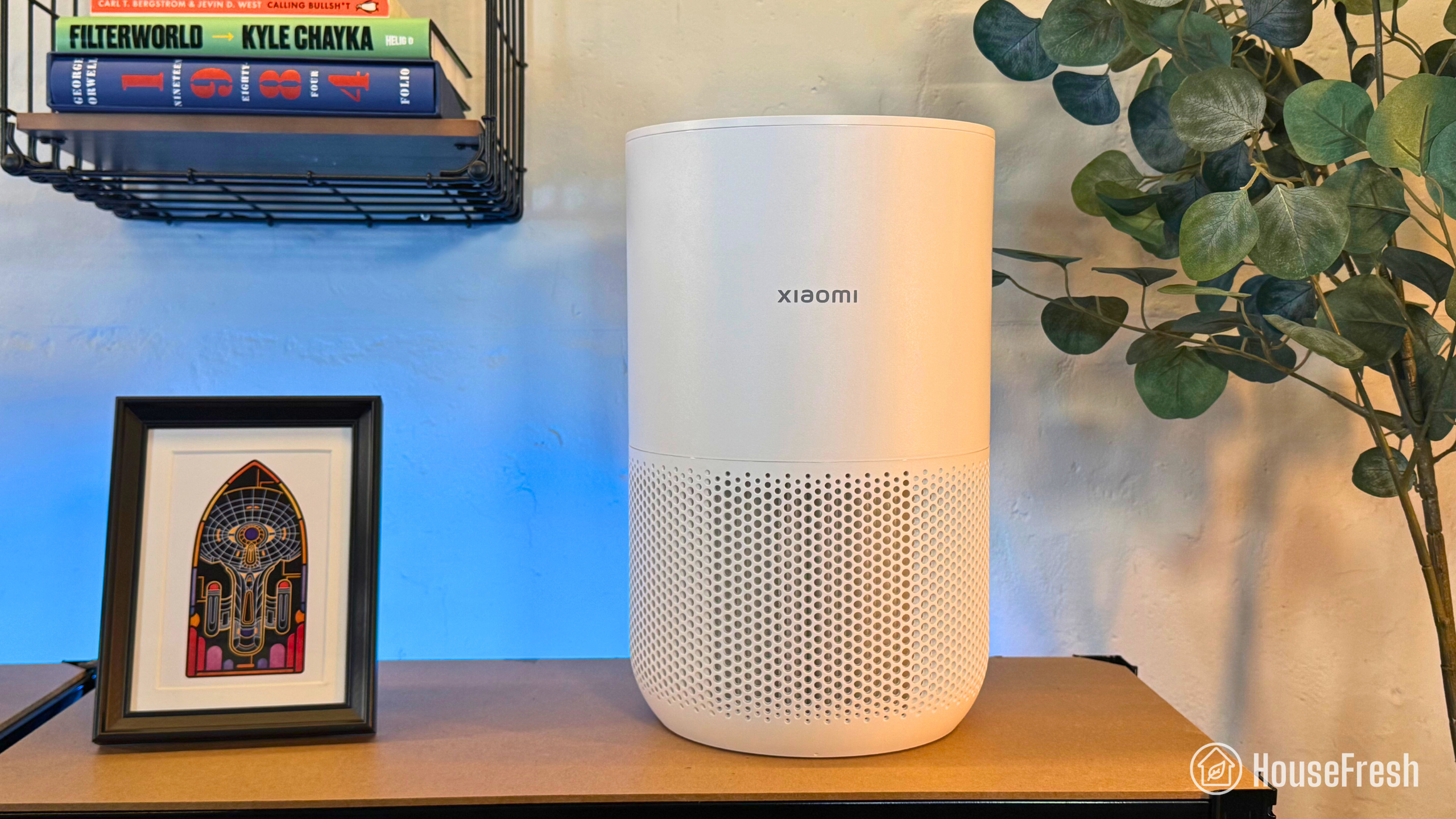
For those looking for a purifier capable of removing dust from the air in very small rooms, my recommendation is the Xiaomi 4 Compact. For most people, I would suggest not going smaller than the Vital 200S (above) but if space is tight, then this $99 air purifier from Xiaomi is my top pick.
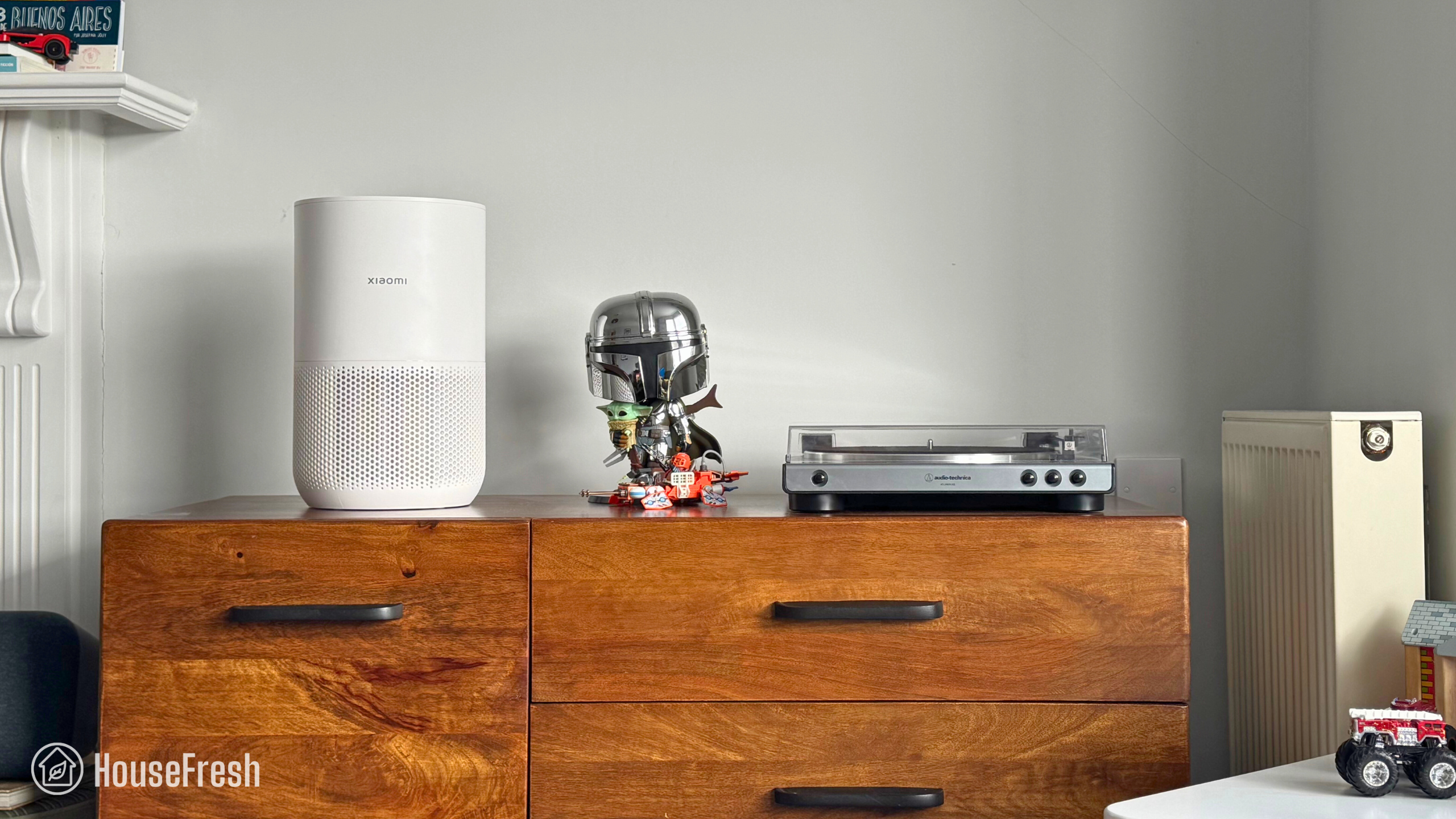
It is a small cylindrical air purifier that doesn’t take up too much floor space with a size similar to what you get with other small air purifiers like the Airmega 100, the Core 300S and the Winix A231.

The filter inside has three levels of filtration: a pre-filter mesh cover for larger dust particles, a non-HEPA grade particle filter for smaller dust particles and a layer of activated carbon to tackle smells.
CONS
PROS
| Clean air delivery rate (CADR): | – Top speed PM1 CADR: 117 cfm – Sub-45 dBA PM1 CADR: 77 cfm – Manufacturer provided CADR: 135 cfm |
| Filter technology: | Bonded cylindrical particle filter with a layer of pelleted activated carbon and a pre-filter mesh cover. |
| Recommended room size: | 175 sq. ft. (5 air changes per hour) |
| Dimensions: | 8.6 x 14 inches (21.8 x 35.5 cm) |
| Weight: | 4.85 lb (2.2 kg) |
| Noise level in decibels from 3 ft. away: | Sleep mode: 35.6 dBA Speed 1: 35.3 dBA Speed 2: 35.6 dBA Speed 3: 42.2 dBA Speed 4: 44.5 dBA Speed 5: 46.4 dBA Top speed: 56.1 dBA |
| Electricity consumption in watts: | Standby: 1.4 watts Sleep mode: 2.2 watts Speed 1: 2.4 watts Speed 2: 3.6 watts Speed 3: 8.1 watts Speed 4: 9.5 watts Speed 5: 11.3 watts Top speed: 26 watts |
| Filter lifespan: | 6 months |
| Manufacturer’s warranty: | 1 year |
| Country of origin: | China |
| Country of manufacture: | China |
4. Best for large spaces: Coway Airmega ProX
A large air purifiers that can clean the air five times per hour in spaces as large as 879 sq. ft. based on its dust CADR of 586 cfm (AHAM).
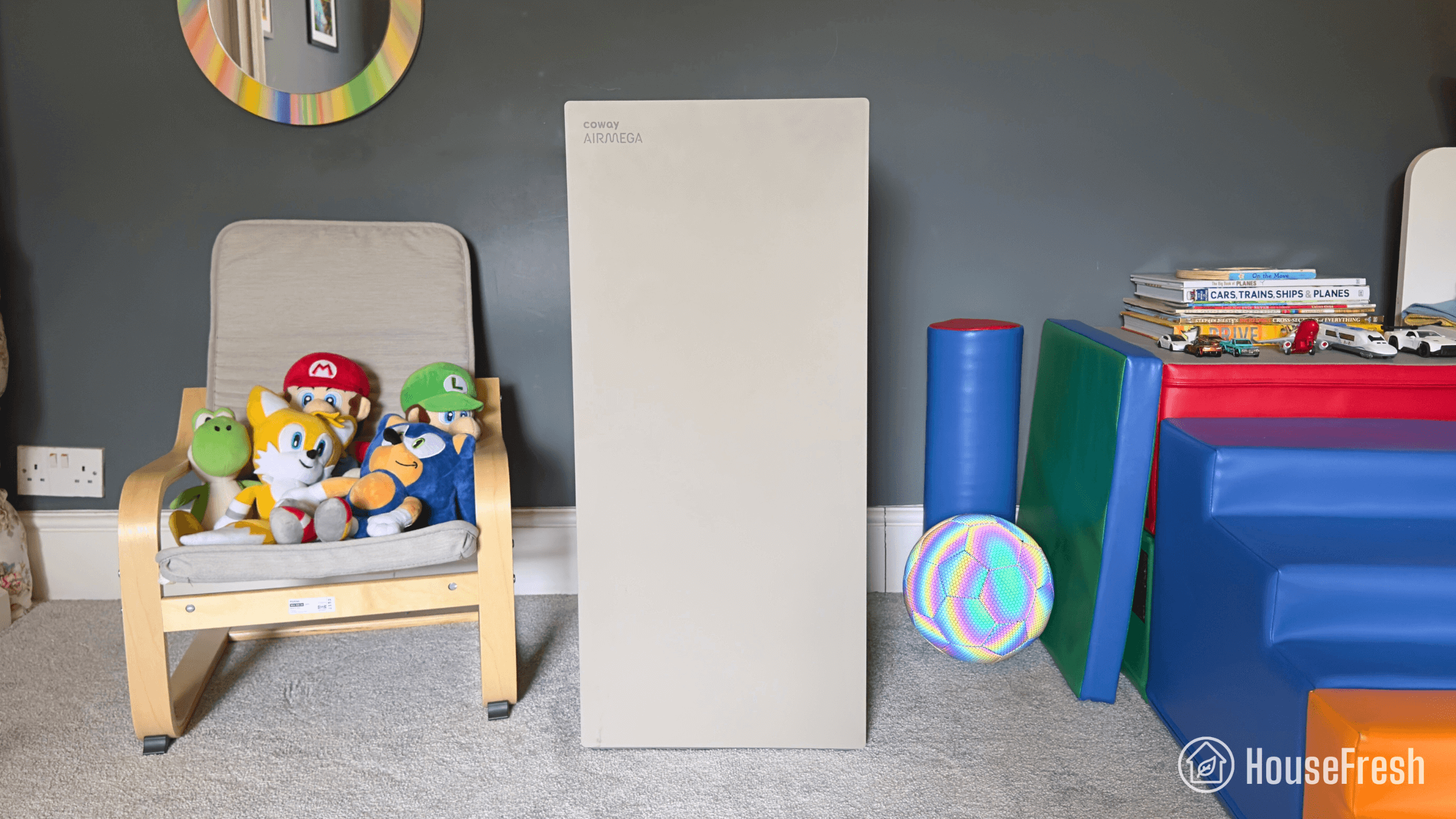
This is the fastest residential air purifier we have ever tested: at top speed, the ProX completed our particle removal test in 13 minutes while generating just 53.6 dBA of noise — this is incredibly quiet considering that the next model in our ranking (IQAir Atem X) reached 62.3 dBA to offer similar performance.
The ProX is the largest device in Coway’s Airmega range. It weighs 51 lbs (23kg) but it comes with wheels and handles at each side that make it easier to move it around the house.
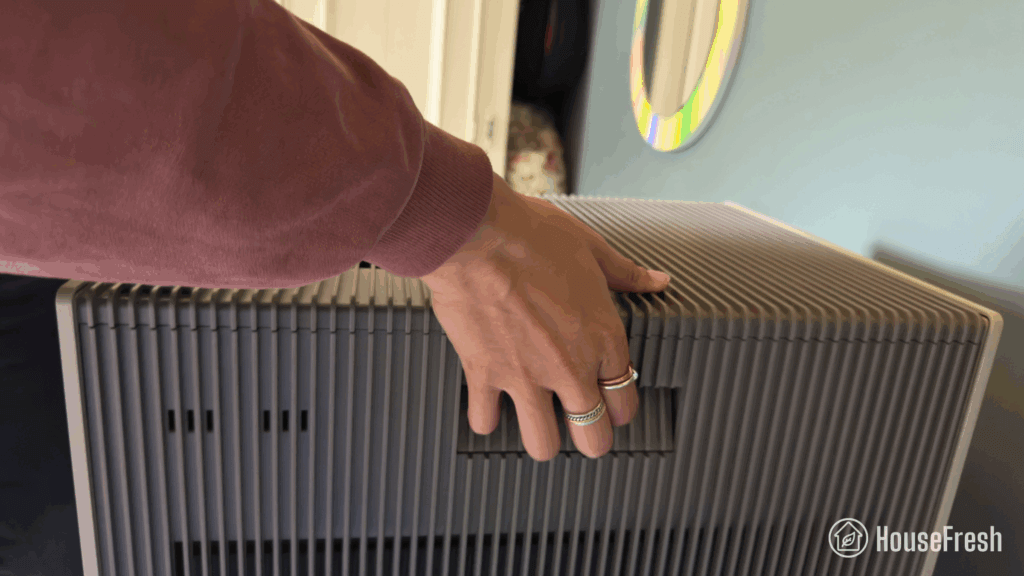
It has an air quality sensor, particle readings on screen and four smart modes that adjust fan speeds automatically based on the level of dust particles in the air.
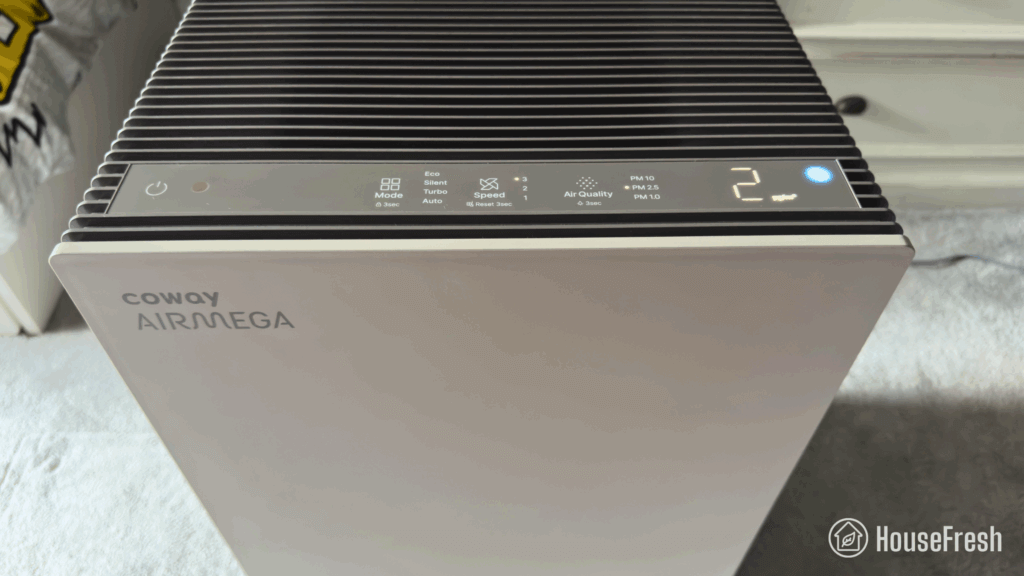
CONS
PROS
| Clean air delivery rate (CADR): | – Top speed PM1 CADR: 462 cfm – Sub-45 dBA PM1 CADR: 299 cfm – AHAM PM2.5 CADR: 586 cfm (dust) |
| Filter technology: | Green True HEPA filter with pelleted activated carbon |
| Recommended room size: | 693 sq. ft. (5 air changes per hour) |
| Dimensions: | 18.9 x 36.6 x 24.3 in (48 x 93 x 62 cm) |
| Weight: | 51 lbs (23kg) |
| Noise level in decibels from 3 ft. away: | Speed 1: 37.4 dBA Speed 2: 44.4 dBA Speed 3: 53.6 dBA |
| Electricity consumption in watts: | Standby: 0 watts Speed 1: 11.76 watts Speed 2: 26.09 watts Speed 3: 58.88 watts |
| Filter lifespan: | 12 months |
| Manufacturer’s warranty: | 3 years |
| Country of origin: | South Korea |
| Country of manufacture: | South Korea |
Special mentions
These air purifiers nearly made my list. Depending on your budget and availability in your location, it could be worth checking them out.

Smart Air SA600
With a dust CADR of 287 cfm (AHAM), this mid-sized air purifier from Smart Air will give you five air changes per hour in rooms up to 430 sq. ft. This is a unique air purifier that uses two sets of H13 HEPA filters, two pelleted carbon filters and two pre-filters.
I didn’t include it in my main list because it offers similar performance to the Vital 200S without any smart functions — if you are not bothered, then definitely look into the SA600.
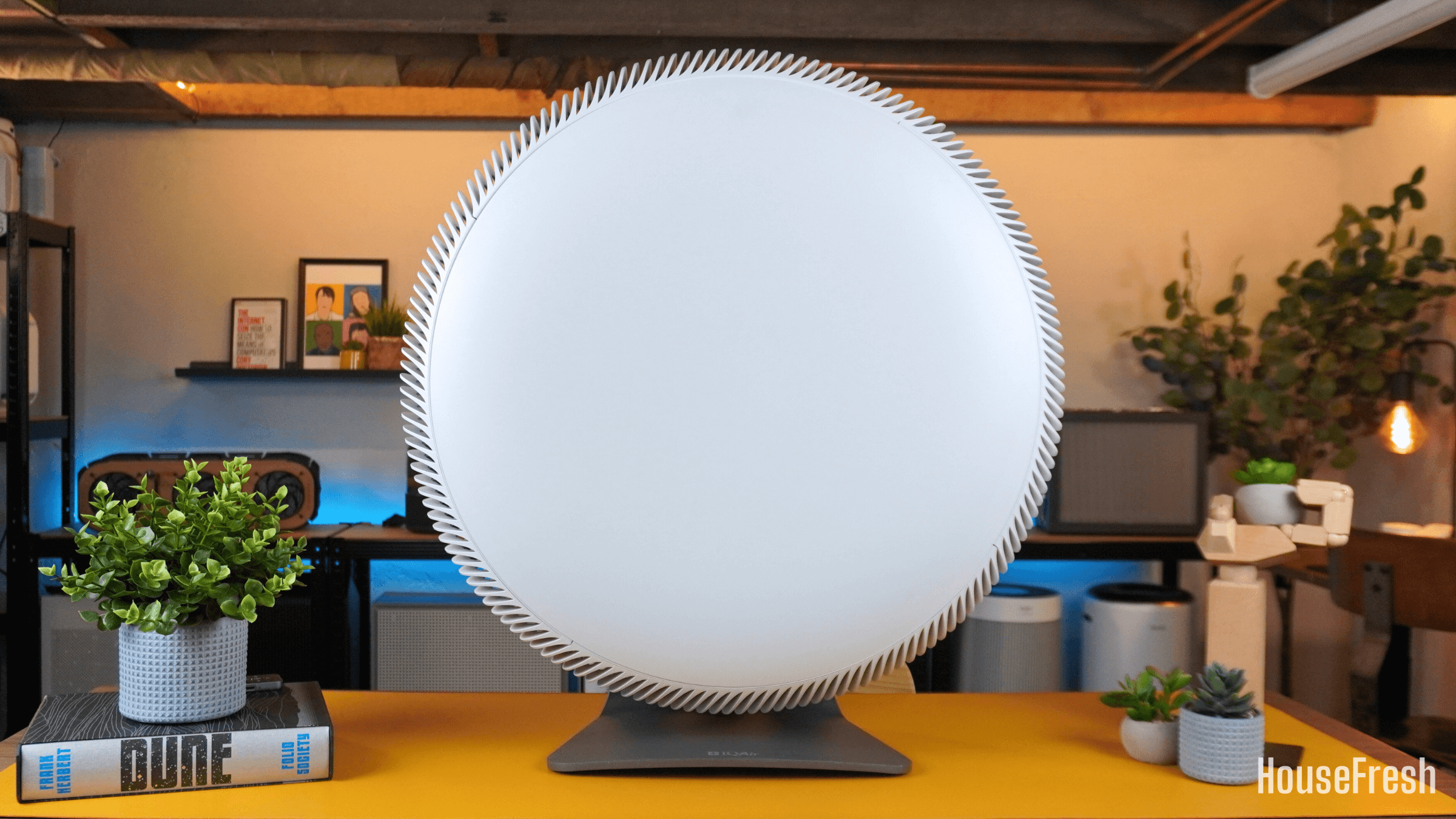
IQAir Atem X
Based on its AHAM report, the Atem X has dust CADR of 435 cfm which will be powerful enough to clean the air five times per hour in rooms no larger than 652 sq. ft.
I didn’t shortlist the Atem X due to its high price tag ($1,399.99), which makes it hard to recommend over the $800 Airmega ProX.
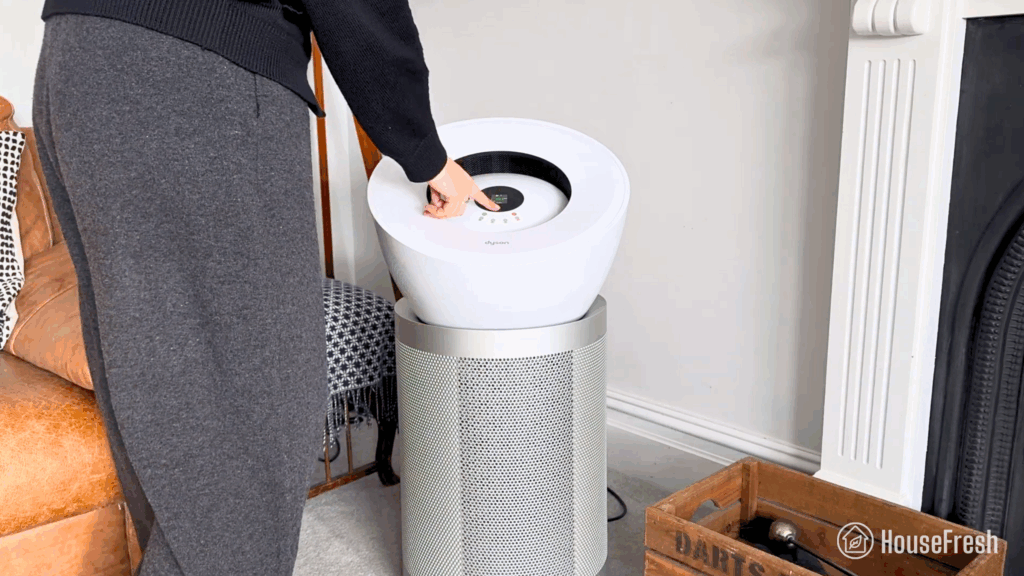
Dyson Big+Quiet BP06
The BP06 is the cheapest model in Dyson’s Big+Quiet range and its performance is good – especially compared to other Dyson units I’ve tested. It has a dust CADR of 190.8 cfm (AHAM) which will clean the air give times per hour in rooms no larger than 286.2 sq. ft. when running at top speed and while generating just 51.4 dbA of noise.
I didn’t include it because it costs the same as the Airmega ProX but it has a third of the air cleaning power.
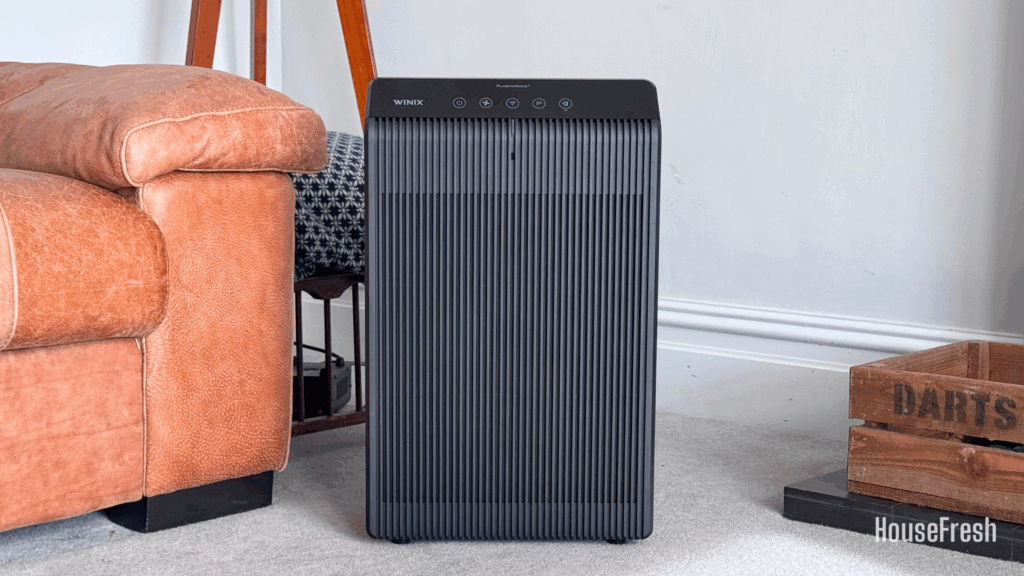
Winix 5510
With a list price $249.99, the 5510 usually goes on deal for less than $200. It offers a dust CADR of 252 cfm (AHAM) at top speed while generating 67.2 dBA. This means it can clean the air five times per hour in spaces up to 378 sq. ft.
I didn’t shortlist it because it can be loud at full speed, but it comes with app connectivity and looks great so you might like it.
Common questions about dust and air purifiers
Yes! Using an air purifier with a high quality particle filter will help remove dust from the air before it settles on your furniture and home surfaces but it won’t completely get rid of dust.
A regular home cleaning routine paired with a good performing air purifier can help keep dust under control but you will still need to dust, vacuum and mop. Here are some quick tips to help you reduce dust in your home:
Dust comprises many different pollutants, from pet dander to pollen, many of which can contribute to allergies. However, when people refer to a specific dust allergy, they usually refer to dust mites.
Dust mites are microscopic critters that feed off dust particles and excess moisture in the air, and they are one of the most common allergens found in the home. When those with allergies to dust inhale or come into contact with dust mites or the proteins they leave behind, they experience symptoms such as sneezing, wheezing, itching, or developing a runny or stuffy nose.
Dust mites will exist in every home worldwide, and although they are nigh-on impossible to eradicate, they can be curtailed and symptoms can be managed. The best way to keep on top of dust mites is to frequently dust your home, keeping the space ventilated and an air purifier running and keeping humidity levels low.
Inhaling small quantities of dust will happen from time to time. Fortunately, our immune system is well equipped to deal with foreign pollutants, such as dust, entering our bodies.
When we inhale dust regularly, however, we may see our immune system kicking into overdrive to help resolve the issue. When this happens, you may recognize having a stuffy nose, itchy eyes or other common allergy symptoms that flair while the dust is in your system.
Being exposed to vast quantities of dust every day over prolonged periods (usually through work rather than domestic exposure) can lead to more serious conditions such as:
- Silicosis
- Lung cancer
- Chronic obstructive pulmonary disease (COPD)
- Kidney disease
If you work in a dusty environment, such as a building or industrial site, then your employer should ensure the necessary PPE and safety precautions are provided.
As dust comprises hundreds of pollutant particles such as skin cells, cloth fibers, and dirt from the earth, it is simply impossible to escape.
Certain homes may be more susceptible to dust build-ups. Sometimes based on what’s inside, such as pets or lots of soft furnishings, sometimes based on the house itself, with gaps by old doors or windows, an old HVAC system, or your local environment being key factors, and sometimes down to having a poor dusting and vacuuming regime.
Be sure to check out our tips for reducing dust in your home.
Wrapping up
Dust is a problem we all have to deal with that is not going away anytime soon. Vacuuming and cleaning your house thoroughly and regularly can help, but you can supercharge your dust-busting routine by introducing an air purifier to capture dust particles flying into the air before they settle on surfaces.
But, before buying an air purifier, remember the key factors to consider:
- Look for a device that uses high quality particle filters – you don’t need to worry about carbon
- Make sure its CADR can provide five air changes per hour, based on the size of your room
- Find a model that is quiet enough for you to run it 24/7
If you have any questions about any of the air purifiers on the list or have recommendations of your own, please drop them in the comments below.


